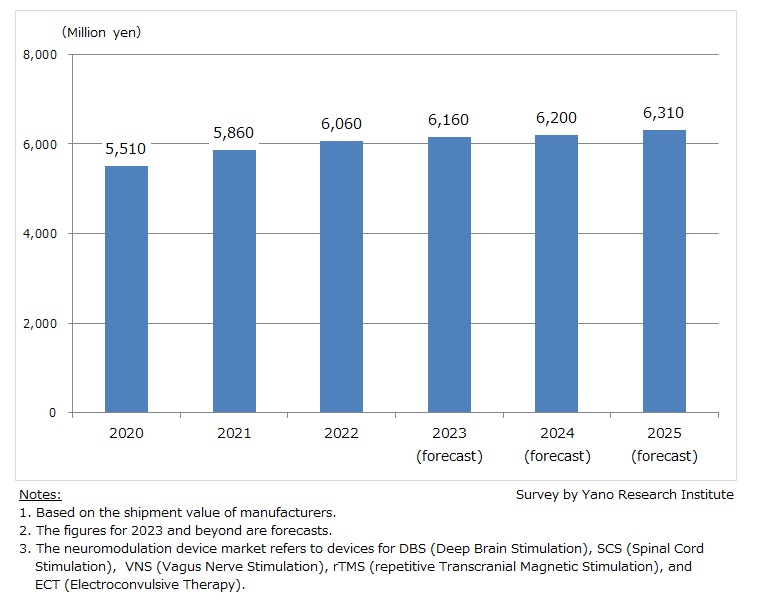No.3461
Neuromodulation Device Market in Japan: Key Research Findings 2023
Neuromodulation Device Market Grew to 6,060 Million Yen in 2022, 103.4% of Preceding Year
Yano Research Institute (President, Takashi Mizukoshi) has conducted a survey on the domestic market of neuromodulation devices and found out the status of various neuromodulation device markets, the trends of neuromodulation therapies, the trends of market players, and future perspectives.

Market Overview
Neuromodulation is a medical therapy using devices that deliver electric or magnetic stimulation, or drugs, to control neural activities. As a medical treatment for diseases and disorders, mild electrical stimulation is delivered via devices, or medication is given continuously to restore/control functions of central nervous system. Neuromodulation devices are broadly classified into two categories: devices for invasive modalities and devices for non-invasive modalities.
Invasive modalities include Vagus Nerve Stimulation (VNS) for refractory epilepsy, Spinal Cord Stimulation (SCS) for intractable chronic pain, and Deep Brain Stimulation (DBS) for Parkinson’s disease and essential tremors, which have been covered for years by the national health insurance in Japan. In addition, non-invasive modalities like Electroconvulsive Therapy (ECT) for depression, bipolar disorder, and schizophrenia, as well as rTMS (repetitive Transcranial Magnetic Stimulation) for a type of depression that has no effective drug therapy are also covered by the national health insurance.
The domestic market of neuromodulation devices as a total of five modalities was estimated at 6,060 million yen for 2022, 103.4% of the preceding year, based on the shipment value of manufacturers. As recognition of neuromodulation increases, expansion of device installation is expected. For this reason, the market size is forecasted to grow to 6,160 million yen in 2023 (101.7% on a year-on-year basis).
Noteworthy Topics
Elucidating Mechanism of Action
As efficacy and safety are verified through clinical research, neuromodulation is spreading widely as a practical medical therapy. Nonetheless, its mechanism of action is still largely unknown, although there are some hypotheses known as the mainstay for understanding. This is posing an issue in expanding the application of neuromodulation or in making diagnosis of the diseases or disorders.
Clinical knowledge regarding the effects and problems of DBS (Deep Brain Stimulation Therapy) has been accumulated extensively. However, even though the effectiveness of the therapy on improving the motor symptoms of Parkinson's disease is obvious, its mechanism of action has not been fully elucidated.
Likewise, despite proven high efficacy, the mechanism of action remains unclear for electroconvulsive therapy (ECT). It is important to understand the mechanism of action because it may lead to the development of therapies that have works immediately and highly with fewer adverse effects. One theory on the ECT’s mechanism of action based on fundamental research is the plasticity hypothesis, which suggests the importance of neuroplasticity, particularly in the hippocampus. Inducing hippocampal plasticity is seen as the target of new antidepressant drug development and is being tested in clinical trials. However, as it is still unclear whether the important part of plasticity is neurogenesis or other plastic changes like synaptic changes, further research is needed. ECT is effective not only for depression but also for psychotic symptoms, catatonia, and motor symptoms of Parkinson's disease. Since the neural basis for treating these symptoms may differ greatly one by one, further research is anticipated.
As mentioned, in spite of various hypotheses and studies to prove their efficacy a definitive mechanism of action of neuromodulation is not clear, even for modalities that are already covered by national health insurance. Elucidating the mechanism of action will contribute significantly to develop relevant diagnosis methods and to expand the application to other disorders. In order to penetrate neuromodulation widely, it is important to promote the development of a new and more efficient therapies based on accumulated results of these treatments.
Future Outlook
We have a projection that the neuromodulation device market grows further hereafter.
In detail, the device used for DBS is expected to lead the market growth, further increasing its market presence. The demand for new installation and replacement are expected to remain constant for devices for SCS and VNS.
Meanwhile, the demand for devices used in rTMS, the modality that was finally covered by insurance in 2019, may be limited for the time being due to various restrictions related to insurance coverage. However, as there are a substantial number of patients with drug resistance, the demand for rTMS is high. Deregulation and the launch of new devices already in preparation for sale may increase presence of rTMS devices in the entire neuromodulation device market.
Research Outline
2.Research Object: Neuromodulation devices suppliers, related academic conferences, etc.
3.Research Methogology: Face-to-face interviews by our expert researchers (including online interviews), surveys by telephone and email, and literature research
What is the Neuromodulation Device Market?
Neuromodulation is a medical therapy using devices that deliver electric or magnetic stimulation, or drugs, to control neural activities. As a medical treatment for diseases and disorders, mild electrical stimulation is delivered via devices, or medication is given continuously to restore/control functions of central nervous system.
The neuromodulation device market in this research refers to devices used in DBS (Deep Brain Stimulation), SCS (Spinal Cord Stimulation), VNS (Vagus Nerve Stimulation), rTMS (repetitive Transcranial Magnetic Stimulation), and ECT (Electroconvulsive Therapy). The market size is calculated based on the shipment value of manufacturers.
<Products and Services in the Market>
Devices for DBS (Deep Brain Stimulation), SCS (Spinal Cord Stimulation), VNS (Vagus Nerve Stimulation), rTMS (repetitive Transcranial Magnetic Stimulation), and ECT (Electroconvulsive Therapy)
Published Report
Contact Us
The copyright and all other rights pertaining to this report belong to Yano Research Institute.
Please contact our PR team when quoting the report contents for the purpose other than media coverage.
Depending on the purpose of using our report, we may ask you to present your sentences for confirmation beforehand.